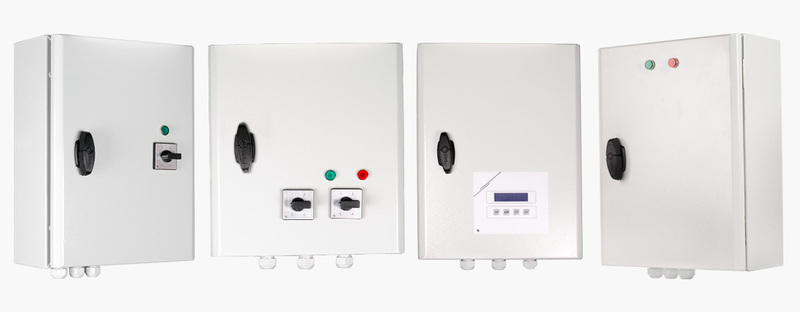Three-phase motor controls - 400 VAC
These transformer controls vary the speed of 3-phase, 400 VAC fan motors in steps. The two autotransformers integrated into each of these controllers adjust the motor voltage, thereby altering its speed. The autotransformers use a special technique to do three phase transformations. This process is highly effective, leading to a substantial reduction in power consumption, up to 95%, and operates noiselessly. More than one fans can be controlled at the same time as long as the total amperage (i.e. maximum current) of all the connected motors does not exceed the maximum controller rating. Additionally, it is crucial for the fans to be identical, and the motors must be specifically designed to facilitate speed control through voltage reduction.
How do I chose the correct type of fan speed controller?
The key aspect is compatibility. You need a controller that is fully compatible with your fan type, which means you must check the voltage and amperage requirements and any other specific features or refer to your motor characteristics. If your 400 VAC fan is equipped with an AC motor and what you want is a step-by-step fan regulation, Sentera’s fan speed controllers are a reasonable choice.
Transformer technology for fan speed control is the best-known method of reducing the supply voltage to a fan motor. Transformer based controllers are extremely dependable and minimise both the motor humming and buzzing, even at low motor speed, and the electromagnetic emissions, which are likely to upset sensitive electronic devices.
From the simplest manually operated controller through analogue input control to demand-based ventilation, these controllers offer a solution to fit everyone’s needs.
The key aspect is compatibility. You need a controller that is fully compatible with your fan type, which means you must check the voltage and amperage requirements and any other specific features or refer to your motor characteristics. If your 400 VAC fan is equipped with an AC motor and what you want is a step-by-step fan regulation, Sentera’s fan speed controllers are a reasonable choice.
Transformer technology for fan speed control is the best-known method of reducing the supply voltage to a fan motor. Transformer based controllers are extremely dependable and minimise both the motor humming and buzzing, even at low motor speed, and the electromagnetic emissions, which are likely to upset sensitive electronic devices.
From the simplest manually operated controller through analogue input control to demand-based ventilation, these controllers offer a solution to fit everyone’s needs.

Manually operated transformer fan speed controllers vary the speed of fan motors via a 1-5 step manual selector knob on the front, which decreases or increases the supply voltage to the motor. The STRS4 series features TK monitoring and the basic STR-4 series is without this feature. The STRA4 series combines the TK function with a 230 VAC alarm output.
More advanced control options comprise a two-speed controller featuring both TK and start-stop contacts for remote on and off switching – the SC2A4 series. In addition to the two built-in switches, this series also has contacts for external timer for high and low speed switching.
The SFPR4 series feature TK monitoring for thermal motor protection and an input for remote start-stop. The relay output can control an external gas supply valve. Gas supply will be enabled only when the exhaust fan is active. If no air flow is detected within 60 seconds, the gas flow will be stopped.
The STTA4 series are equipped with a thermomagnetic breaker for protection of motors, contacts for remote start-stop as well as a 230 VAC alarm output.
The controllers featuring calendar function – ST2R4 - have a built-in timer, thanks to which they can operate autonomously. Two optimal speeds can be selected and switched both manually via the built-in keyboard and automatically via the programmable timer functionality. Besides being a standalone device, this type of controllers feature a USB port for connection to a computer. What you get is easy reading, changing and writing all device parameters via the free downloadable 3SMUsb software (part of 3SM Center).
The STVS4 series controls the motor via an analogue input using a 0 - 10 V control signal provided by an external device. This could be a sensor or an external potentiometer. If a potentiometer is connected, the control signal is sent manually by rotating the potentiometer. However, if a sensor is connected, ventilation could be based on its measurements, be it temperature, relative humidity, CO2 or any other parameter.
These products may only be connected to a 400 VAC power supply. It is imperative that the device undergoes inspection by a qualified technician before applying any voltage. Prior to accessing the internal components, isolate the device from the electrical supply. Adhere to all pertinent safety precautions, wiring and earthing regulations and electrical ratings during installation.
It is essential to always ensure that the devices operate within its specified electrical rating. In cases where the failure of the device can result in damage, it is advisable to install a safety backup control. Prioritize safety measures and follow industry standards diligently at all times.
